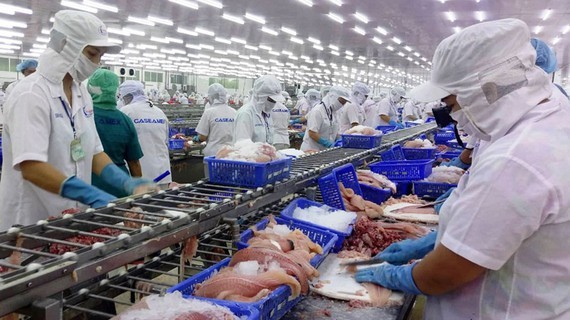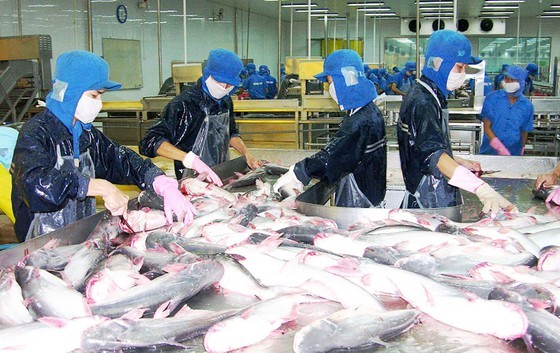
Mr. Cao Luong Tri, a farmer in Cho Moi District in An Giang Province, said that this year is considered to be the gloomiest year for fish farmers in the Mekong Delta provinces when the price of pangasius fish merely fluctuated from VND18,000 to VND20,000 per kilogram, causing a loss of VND3,000-VND5,000 per kilogram for farmers. This situation is totally different from that in 2018. Due to low prices and poor consumption, he decided to hold more than 700 tons of his pangasius fish.
Some fish ponds in Dong Thap, Vinh Long, Ben Tre provinces and Can Tho City have also passed the harvest time with the weight of some fish up to 1.3-1.4 kilograms per fish but factories still neglect to buy. At the present, although it is the end of the year, the price of material pangasius fish has dropped to around VND17,500-VND18,000 per kilogram, depending on payment method.
Mr. Nguyen Van Tan, a farmer in Vinh Thanh Trung Commune in Chau Phu District in An Giang Province, said that if the situation was not improved soon, several fish-farming households would be empty-handed and suffer huge losses and there would be no Tet holidays for them.
According to the Directorate of Fisheries under the Ministry of Agriculture and Rural Development, since the beginning of this year, farmers in provinces in the Mekong Delta have raised pangasius fish on an area of more than 7,127 hectares, an increase of up to 2,086 hectares compared to the same period last year as the price of pangasius fish was extremely high last year, urging enterprises, fish-farming facilities and households to expand production. An increase in material areas along with difficulties in export market, especially large export markets, as well as the fact that Indonesia, China and Bangladesh have invested in the development of pangasius fish, have caused a slump in export of pangasius fish of Vietnam.
Some fish ponds in Dong Thap, Vinh Long, Ben Tre provinces and Can Tho City have also passed the harvest time with the weight of some fish up to 1.3-1.4 kilograms per fish but factories still neglect to buy. At the present, although it is the end of the year, the price of material pangasius fish has dropped to around VND17,500-VND18,000 per kilogram, depending on payment method.
Mr. Nguyen Van Tan, a farmer in Vinh Thanh Trung Commune in Chau Phu District in An Giang Province, said that if the situation was not improved soon, several fish-farming households would be empty-handed and suffer huge losses and there would be no Tet holidays for them.
According to the Directorate of Fisheries under the Ministry of Agriculture and Rural Development, since the beginning of this year, farmers in provinces in the Mekong Delta have raised pangasius fish on an area of more than 7,127 hectares, an increase of up to 2,086 hectares compared to the same period last year as the price of pangasius fish was extremely high last year, urging enterprises, fish-farming facilities and households to expand production. An increase in material areas along with difficulties in export market, especially large export markets, as well as the fact that Indonesia, China and Bangladesh have invested in the development of pangasius fish, have caused a slump in export of pangasius fish of Vietnam.

Processing pangasius fish for export in Tra Noc 2 Industrial Zone, O Mon District, Can Tho City. (Photo: SGGP)
Regarding shrimps, from March to August this year, the price of shrimps had fallen heavily, affecting export turnover of the whole industry as India and Ecuador enjoyed a bumper crop of shrimps, leading to low cost price and plentiful supply. Because the cost price of shrimps in the Mekong Delta provinces was high so many enterprises imported material shrimps from India at cheaper prices, causing pressure on domestic shrimps and excessive shrimp supply. In addition, many markets increased technical barriers, sending Vietnamese enterprises into a difficult situation.
Mr. Tran Dinh Luan, head of the Directorate of Fisheries, said that the price of shrimps have rebounded recently and the EU market has increased buying at the end of the year while consumption at other markets, including Canada, Japan and South Korea, was fairly good. Besides, the impacts of free trade agreements will create a foundation for seafood enterprises to increase competitiveness. As for pangasius fish, as the export speed has not improved and the price is still low so fish-farming households and enterprises need to adjust the stocking density and reduce supply at the end of this year and at the beginning of next year.
Mr. Truong Dinh Hoe, general secretary of the Vietnam Association of Seafood Exporters and Producers, said that it is forecast that shrimp exports will reach $3.4 billion this year, down 4 percent over the previous year, and pangasius fish exports will touch $2.23 billion, down 3 percent due to unfavorable factors. The urgent solution is to ensure the balance between supply and demand of pangasius fish so as to avoid overproduction. It is necessary to have full and accumulative data to assess accurately the situation. The industry needs to increase investment in good sources of fingerlings and focus on improving the quality of material pangasius fish in order to officially export to large markets. Provinces need to tighten control on farming areas in accordance with planning, apply new technology and control well the environment. As for shrimps, it is essential to quickly reduce raising cost price to increase competitiveness against other countries and rearrange shrimp-farming areas to establish large-scale farms and cooperatives that are certified to meet international standards. Investment in infrastructure of farming areas must be increased and the irrigation network must be ensured to prevent diseases from spreading. In the long-term, it is necessary to build brand name for Vietnamese shrimps.
The leader of the Department of Agriculture and Rural Development of Ca Mau Province said that it would actively restructure shrimp farming in the direction of establishing cooperative groups and cooperatives, building chains from farming to consumption, and multiply biosecurity and environmentally-friendly farming models to aim at sustainable shrimp farming. According to Mr. Nguyen Si Lam, director of the Department of Agriculture and Rural Development of An Giang Province, the province has promulgated a resolution on policies to support connection of production and consumption of agricultural products. This will encourage the connection between seafood enterprises, fingerling producers and fish-farming households to develop the chain stably and sustainably.
Mr. Tran Dinh Luan, head of the Directorate of Fisheries, said that the price of shrimps have rebounded recently and the EU market has increased buying at the end of the year while consumption at other markets, including Canada, Japan and South Korea, was fairly good. Besides, the impacts of free trade agreements will create a foundation for seafood enterprises to increase competitiveness. As for pangasius fish, as the export speed has not improved and the price is still low so fish-farming households and enterprises need to adjust the stocking density and reduce supply at the end of this year and at the beginning of next year.
Mr. Truong Dinh Hoe, general secretary of the Vietnam Association of Seafood Exporters and Producers, said that it is forecast that shrimp exports will reach $3.4 billion this year, down 4 percent over the previous year, and pangasius fish exports will touch $2.23 billion, down 3 percent due to unfavorable factors. The urgent solution is to ensure the balance between supply and demand of pangasius fish so as to avoid overproduction. It is necessary to have full and accumulative data to assess accurately the situation. The industry needs to increase investment in good sources of fingerlings and focus on improving the quality of material pangasius fish in order to officially export to large markets. Provinces need to tighten control on farming areas in accordance with planning, apply new technology and control well the environment. As for shrimps, it is essential to quickly reduce raising cost price to increase competitiveness against other countries and rearrange shrimp-farming areas to establish large-scale farms and cooperatives that are certified to meet international standards. Investment in infrastructure of farming areas must be increased and the irrigation network must be ensured to prevent diseases from spreading. In the long-term, it is necessary to build brand name for Vietnamese shrimps.
The leader of the Department of Agriculture and Rural Development of Ca Mau Province said that it would actively restructure shrimp farming in the direction of establishing cooperative groups and cooperatives, building chains from farming to consumption, and multiply biosecurity and environmentally-friendly farming models to aim at sustainable shrimp farming. According to Mr. Nguyen Si Lam, director of the Department of Agriculture and Rural Development of An Giang Province, the province has promulgated a resolution on policies to support connection of production and consumption of agricultural products. This will encourage the connection between seafood enterprises, fingerling producers and fish-farming households to develop the chain stably and sustainably.
























